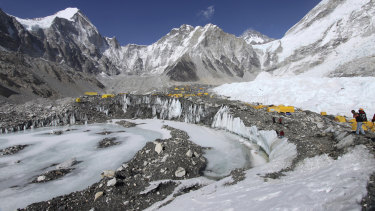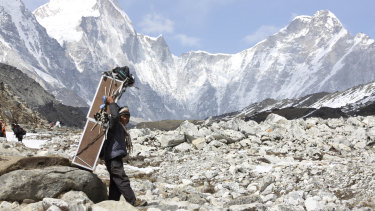Coronavirus reaches Everest base camp, the ‘perfect setup for a superspreader event’
Washington: When Nepal welcomed foreign climbers back to Mount Everest for the northern spring climbing season, many feared it was only a matter of time before the coronavirus made its way to the world’s highest peak.
Sure enough, just weeks into the season, symptoms of the virus have been found at Everest’s base camp, sparking a renewed debate about whether Nepal’s reliance on the mountain as a source of revenue is getting in the way of safety.
On Wednesday, Outside magazine first reported a climber at base camp had been evacuated by helicopter for what was believed to be high-altitude pulmonary edema and tested positive for the coronavirus upon arriving at a hospital in Kathmandu last week.
Tents are seen set up at Everest Base Camp in Nepal.Credit:AP
The New York Times subsequently revealed that in fact there had been multiple climbers who tested positive after being flown out of base camp.
The exact number of cases is unknown, and Nepal’s tourism ministry did not respond to a request for comment.
“We can be almost sure there have been other cases already this year that were misdiagnosed or hidden, and that there will be more,” said Adrian Ballinger, the founder of Alpenglow Expeditions, which chose to cancel its Everest treks this spring.
A porter carries crates containing oxygen tanks on his way towards Everest Base Camp.Credit:AP
With infections rising in Nepal as neighbouring India grapples with an out-of-control outbreak that is driving a global surge, the crowded camps and their rotating crew of porters and yak drivers provide “the perfect setup for a superspreader event,” Ballinger said.
Making matters even worse, many common coronavirus symptoms bear a close resemblance to the symptoms of altitude sickness and the “Khumbu cough” that often plagues climbers at high altitudes.
As of Wednesday, Nepal’s tourism department had issued 377 climbing permits to foreign climbers attempting to scale Everest this year – close to the same number issued in 2019, when 11 people died on the peak and numerous fatalities were blamed on the long wait to descend from the summit to base camp.
As one of the poorest countries in Asia, Nepal is heavily dependent on foreign tourists, some who see Everest as the culmination of a lifelong dream.
The government has already collected more than $US3.8 million in fees from climbing permits this year, and the amount of money that climbers spend while in the country typically accounts for an estimated $US300 million in revenue.
Last year, that income source vanished as the pandemic hit and Nepal closed its borders, cancelling climbing expeditions. Nepali mountain guides – including some of the best climbers in the world – suddenly found themselves in poverty, forced to rely on growing rye and potatoes for sustenance.
In the wake of a rough year, Nepal has welcomed climbers back for the popular northern spring season, even though the pandemic is nowhere near over. Though a number of international trekking companies cancelled their Everest expeditions, the ExplorersWeb blog noted, “local companies themselves have been happy to welcome whoever signs up.”
So far, the possibility of a coronavirus outbreak at base camp hasn’t put a damper on plans.
Meanwhile, masks and social distancing are not in wide use in the Everest area In Nepal’s Khumbu Valley, which trekkers hike through on the way to base camp. People have been “living life effectively normally,” Ballinger said last month. “That’s worked thus far because there hasn’t been an introduction of lots of COVID to the valley.”
Alpenglow Expeditions made the decision to cancel Everest excursions this spring after coming to the conclusion that “there was no way we could avoid COVID cases and no way we could treat COVID cases,” Ballinger said.
Having 300 climbers on the mountain means bringing in roughly 500 Nepali support staff who work as porters and assistants, often for multiple teams at the same time. Yak drivers deliver food every few days.
“It’s just not practical to think we’re going to be able to keep all those staff people completely isolated,” Ballinger said.
Fearful of adding to Nepal’s already overburdened health system, Ballinger also worried that climbers who develop the coronavirus might mistake their symptoms for altitude sickness and insist on staying on the mountain. He noted that many higher-end companies cancelled their treks this spring while lower-budget operators insisted on forging ahead, potentially leading to a dangerous mix of inexperience and overcrowding on the mountain.
Crowding was a major concern even before the pandemic, and Nepal pledged to enact stricter permitting rules for Everest after mountaineers recounted stepping over dead bodies on their way to the summit.
So far, however, the only new rule that has gone into effect is one banning photographs – which many view as an attempt to limit negative publicity.
Everest is a typical case of the coronavirus bringing a societal issue that already existed into sharper relief, Ballinger said: “The problem is there’s zero enforcement on the mountain.”
The Washington Post
Most Viewed in World
From our partners
Source: Read Full Article

